What is insurance automation?
Insurance automation applies software to simplify policy and claims processes. RPA and AI technologies streamline tasks like submitting claims, making them more efficient and error-free. Other complex insurance processes like pre-qualification, regulatory compliance, and underwriting also benefit from automation.
Insurers who rely on automation technologies report more efficiency, accuracy, scalability, and consumer satisfaction than competitors who still use traditional insurance processes. However, despite 92% of policyholders asking for self-service claims solutions, the insurance industry is just starting to adopt automation solutions.
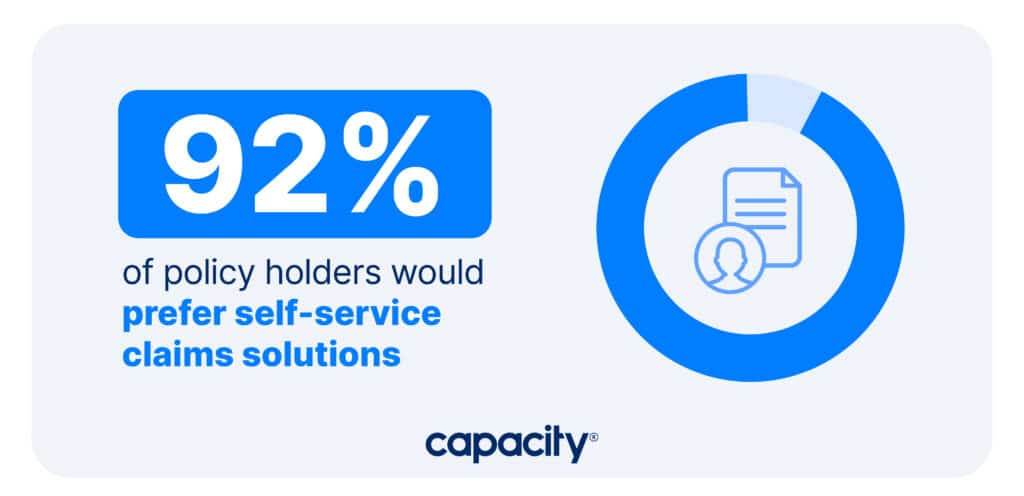
With AI and automation expected to become a $190 billion industry by 2025, the pressure on insurers to stay relevant while continuing to scale grows with each passing year. Implementing automation in insurance is one of the most reliable, surefire ways to spur tangible business growth and development in the digital age.
What can be automated in insurance?
Extracting information from regulatory databases, updating customer files, and routing paperwork are all repetitive tasks that RPA (or robotic process automation) can perform. Automation in insurance is a quickly growing technology with many opportunities for innovation.
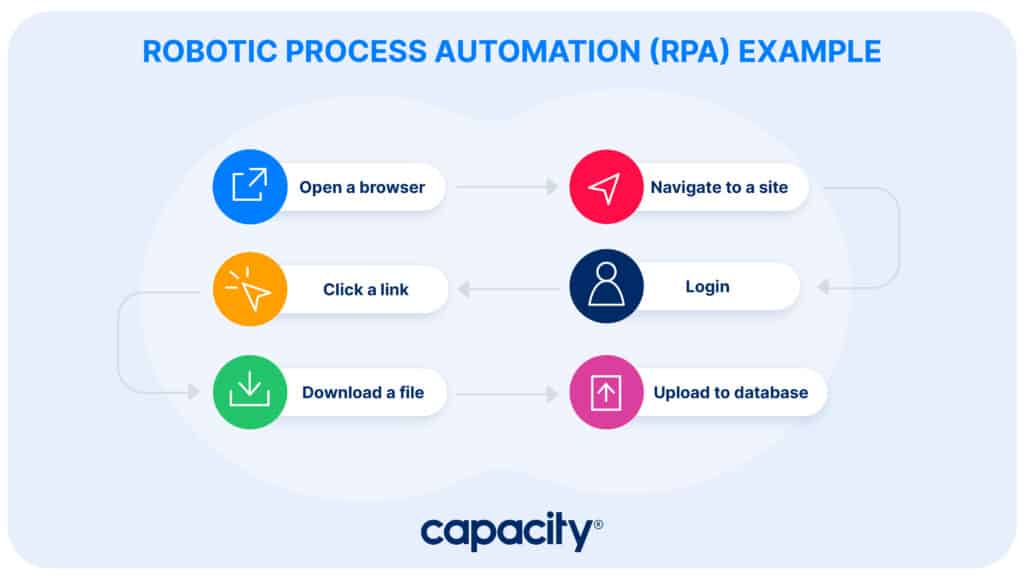
Another important aspect of insurance automation is artificial intelligence. Able to instantly and accurately answer questions about regulations or policies, AI saves policyholders, claims adjusters, and underwriters the headache of spending hours searching for information or correcting mistakes.
RPA and AI work together to automate lengthy, manual processes that would typically cost employees hours and involve mountains of paperwork. Ultimately, implementing automation in insurance lessens employee burdens, minimizes errors, and increases turnaround times.
4 Benefits of RPA and Automation in Insurance
Many insurers hesitate to adopt RPA and automation in insurance, which makes sense. Cost, platform training, and implementation can seem like intimidating or confusing barriers. However, the advantages of using automation far outweigh any of these obstacles. Companies who choose insurance automation report a 55% increase in productivity, an 80% increase in accuracy, and 4 times their average revenue savings in 2023 than in 2019.
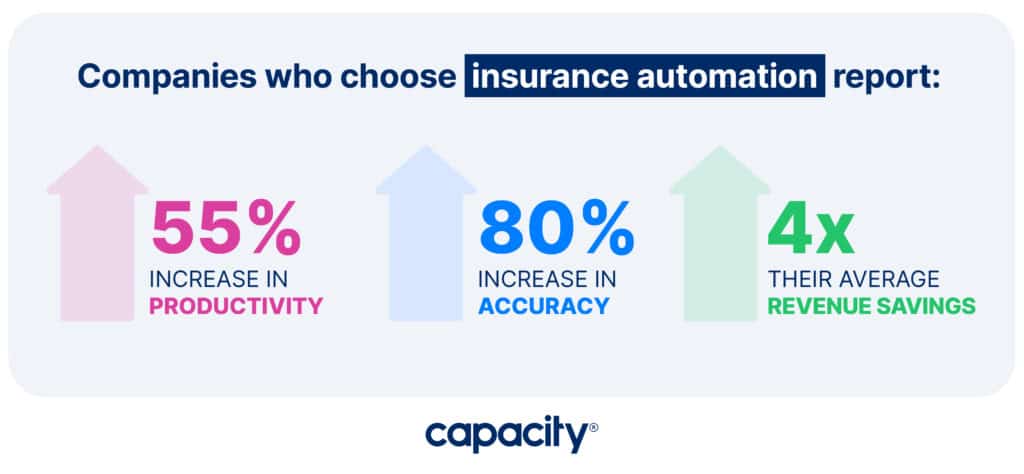
So, what are the benefits of implementing automation in your insurance process?
1. Optimized Efficiency in Insurance
Insurance is an extremely technical, regulated, and competitive industry. Claims adjusters and underwriters have traditionally spent days, even weeks, on sifting policies, entering data, and finding the correct regulations. But with the development of insurance automation, long turnaround times have become a relic of the past.
RPA and AI can instantly mine databases, hundreds of pages of fine print, and emails for information. These tools are so efficient that they reduce 69% of employee time spent on data processing and increase decision-making speed by 55%.
Insurance automation alleviates the burden of menial work, so claims adjusters and underwriters focus more and better on crucial, high-skilled tasks. Ultimately, tools like RPA and AI reduce burnout and increase productivity.

Automate Your Work
Capacity’s enterprise AI chatbot can help:
- Answer FAQs anytime, anywhere
- Find relevant documents within seconds
- Give surveys and collect feedback
2. Insurance Automation = Competitive Accuracy
Another crucial but painstaking aspect of insurance processing is accuracy. Tasks such as calculating risks and damages and pulling applicable regulations demand attention to detail and complete certainty. Otherwise, a single mistake on a claim can cost insurers and policyholders millions of dollars.
Insurance automation aims to reduce that margin of error. RPA and AI, as trained technologies, are more reliable than the human mind. They are unaffected by distractions, emotions, sensations like hunger or fatigue, or simple oversight.
Able to process and analyze massive amounts of data, RPA and AI more precisely pull up-to-date regulatory information and policy changes. Claims adjusters and underwriters who use insurance automation can provide policyholders with the most error-free assessments and quotes.

With trust in AI-backed claims at a whopping 79%, insurance automation is transforming claims and underwriting procedures and granting a competitive advantage to those who choose it.
3. Better Consumer Experiences via Automation
As automated insurance processes evolve, customer relationships will undoubtedly follow suit. Human interaction is still a driving factor in building and retaining a customer base, even in a business backed by insurance automation. The trick is to create a great experience that is cost-friendly.
The “human in the loop” practice is an emerging principle of automated insurance processes: the technique “provides customers with access to human support if and when they need it.” This customer-centric principle allows policyholders to lead their own insurance experience, appealing to all customer demographics regardless of their comfort level with chatbots or digitally guided claims applications.
To maximize the benefits of this practice, businesses using insurance automation must track their customer journeys and adapt any external digital processes to their preferences. But since happier customers equal higher revenues, the additional effort spent on tailoring their experiences is invaluable.
4. Insurance Automation to Scale
Because insurance automation is both more efficient and more accurate than traditional processes, insurers who implement it benefit from higher productivity, higher quality work, and higher customer retention. These translate into a reputable business that can expand and scale faster at a lower cost.
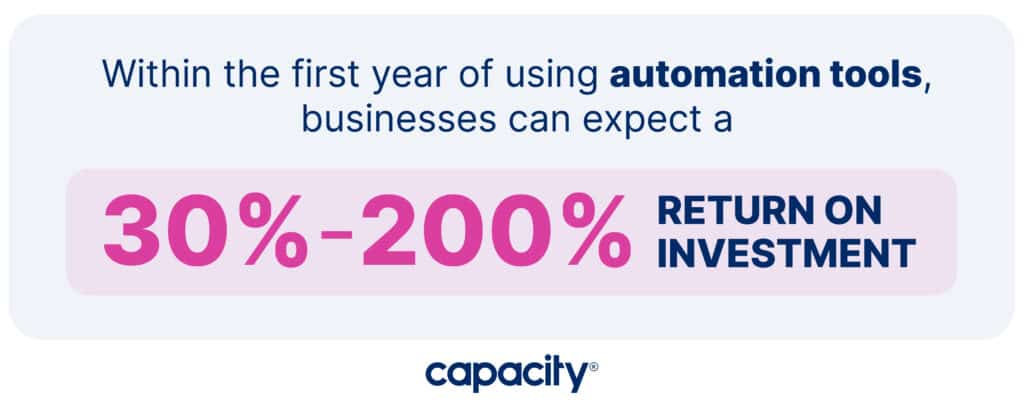
According to a London School of Economics study, businesses can expect a 30 to 200% return on investment within the first year of using automation tools. With the insurance industry predicted to transform from “detect and repair” into a “predict and prevent” model by 2030, the impact of implementing automation in insurance processes is crucial to surviving and thriving in the digital age.
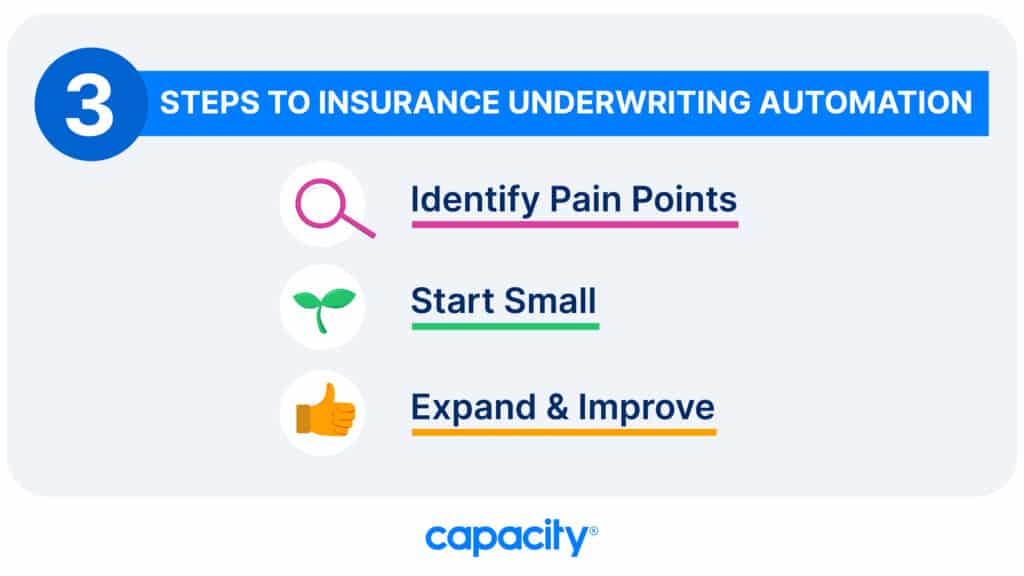
3 Steps to Insurance Underwriting Automation
Underwriting, the process of calculating risk, is the foundation of an insurance policy. It is also repetitive and complex. Reliance on historical data and the laborious process of aggregating it makes underwriting the ideal candidate for insurance automation tools.
But how do you automate insurance underwriting?
1. Identify Pain Points to Automate
Data used by underwriters tends to become less relevant as time passes, meaning insurers must spend time and money on constantly collecting new data. Even with the most pertinent data, underwriting is a paper-heavy, time-consuming process that hampers productivity.
But it doesn’t have to be. Automated insurance tools take on the burden of repetitive, detail-heavy tasks so that underwriters can make precise, expedited assessments.
To implement these tools, first, take steps to identify the bottlenecks in your underwriting process. Common pain points that can be automated include:
• Data extraction and classification from multiple sources
• Form filling and updating
• Maintenance of compliance logs and databases
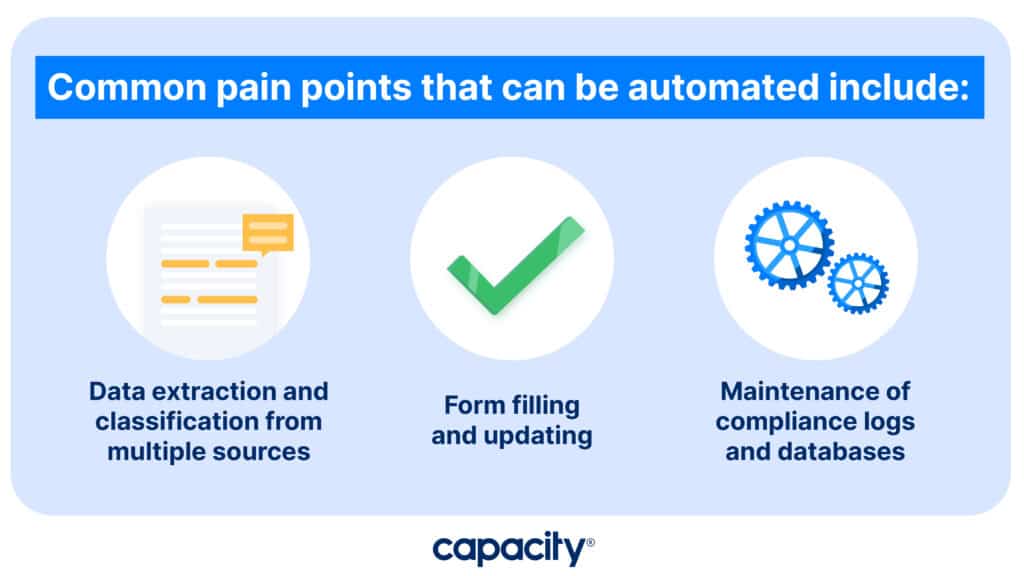
2. Automate Small Insurance Processes
With your pain points identified, the next step is to apply your automation tool at its most basic level. The best way to maximize insurance automation’s productivity and cost returns is to stagger your implementation, beginning with the smallest applications as your foundation and then building upwards.
Using RPA to pull data from spreadsheets, PDFs, and emails is an excellent place to start that would drastically decrease low-level production times. Another simple application is using AI to predict entries on standard forms.
As underwriters train on the tools and spend less time on mundane tasks, they can focus on more complex analyses. Additionally, because automation tools have a smaller margin of error, underwriting work becomes more accurate, reducing cost and labor.

Automate Your Work
Capacity’s enterprise AI chatbot can help:
- Answer FAQs anytime, anywhere
- Find relevant documents within seconds
- Give surveys and collect feedback
3. Expand & Improve Insurance Automation
Now that you have laid the foundation of your automated insurance processes, you can begin to apply the tools at higher levels. More pain points and automation opportunities will become apparent as experience with the technology grows.
For example, underwriters can use AI to predict risk profiles and exposure, implement competitive dynamic pricing, and automatically tailor policies to customer situations and needs.
Expand and improve your insurance automation technology — and enjoy the added benefits of faster application decisions, competitive premiums, and a more sustainable, profitable underwriting team.
How do you automate an insurance claim?
Automated insurance policies enhance many aspects of the business, including claims. Because 87% of customers say claims process efficiency affects their choice of insurance vendor, getting that process right is paramount.
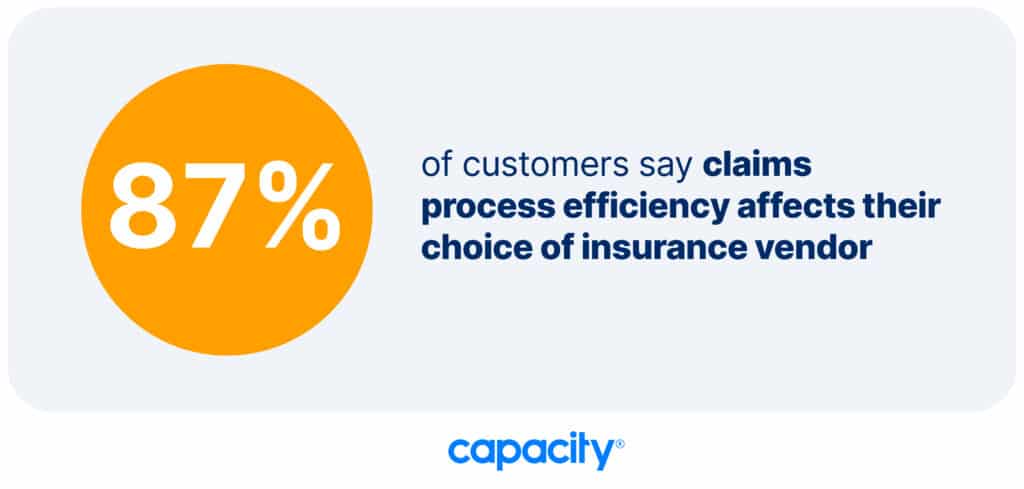
RPA and AI are the best tools to optimize and scale your claims process. They reduce the need for manual work for both policyholders and claims adjusters. Some of the most beneficial uses for RPA and AI in insurance include:
• Guiding policyholders to submit information in claims applications without the need for employee assistance
• Extracting information from paper claims submissions on behalf of adjusters
• Classifying and entering that information into a database for the adjuster to reference easily, in one place
Simpler claims applications and increased processing speed contribute to higher customer satisfaction; the freedom for adjusters to focus on higher-level tasks leads to greater productivity. Additionally, the risk of fraud and error lessens significantly.
When repetitive tasks are handled by intelligent insurance automation, the entire claims process becomes fast, easy, and scalable.

Meet Capacity: Your Insurance Automation Platform
Keep three priorities in mind while choosing insurance automation technologies:
• End-to-end integration: choose tools that work with all of your legacy systems.
• Cloud-based accessibility: ensure your tools are accessible from anywhere.
• Ease of use: prioritize tools that strive to be low-code and training-friendly.
Capacity is an all-in-one insurance automation platform that uses RPA and AI to streamline claims and underwriting processes, assist policyholders, and ensure compliance. Designed to connect to all existing systems, collect company information into one place, and work for everyone, anywhere, Capacity empowers insurers and policyholders alike.
Insurance automation is the future of the industry, and the benefits of using it outweigh the cost by 3 to 10 times.





